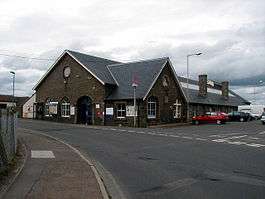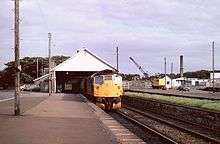Wick railway station
| Wick | |
|---|---|
| Scottish Gaelic: Inbhir Ùige[1] | |
 An external view of Wick railway station | |
| Location | |
| Place | Wick |
| Local authority | Highland |
| Coordinates | 58°26′30″N 3°05′51″W / 58.4416°N 3.0975°WCoordinates: 58°26′30″N 3°05′51″W / 58.4416°N 3.0975°W |
| Grid reference | ND360509 |
| Operations | |
| Station code | WCK |
| Managed by | Abellio ScotRail |
| Number of platforms | 1 |
|
Live arrivals/departures, station information and onward connections from National Rail Enquiries | |
| Annual rail passenger usage* | |
| 2012/13 |
|
| 2013/14 |
|
| 2014/15 |
|
| 2015/16 |
|
| 2016/17 |
|
| History | |
| Original company | Sutherland and Caithness Railway |
| Pre-grouping | Highland Railway |
| Post-grouping | LMS |
| 28 July 1874 | Opened[2] |
| Listed status | |
| Listing grade | Category B listed building (since 15 December 1998) |
| Added to list | 28 November 1984 |
| National Rail – UK railway stations | |
| * Annual estimated passenger usage based on sales of tickets in stated financial year(s) which end or originate at Wick from Office of Rail and Road statistics. Methodology may vary year on year. | |
|
| |
Wick railway station is a railway station serving the town of Wick, in the Highland council area in the north of Scotland. The station is the terminus of the Far North Line, near Wick police station and Caithness General Hospital, within the former county of Caithness.
History

The station was designed by Murdoch Paterson and built by the Sutherland and Caithness Railway, opening the line in 1874.[2][3] A wrought-iron turntable of 45 feet (14 m) diameter built by the Railway Steel and Plant Company of Manchester was installed at the station[4] along with an engine shed with the capacity for housing four engines, and a special loading bank for the loading of herring for the southern markets.
On 1 July 1903, the station became the junction with the Wick and Lybster Light Railway.[5] The last trains to Lybster ran in 1944, although the line was not officially closed until 1951.
On 30 June 1909, Peter Doull, a coal trimmer, was killed by a train in the coal siding.[6]
On 3 May 1941, a goods train going into the station collided with an empty carriage at the platform. The buffers failed to stop the carriage which was carried forward and piled up onto the platform, where one end crashed into the Menzies bookstall. The platform buffers were found buried beneath the wreckage of the bookstall.[7]
The station is 161 miles 35 chains (259.8 km) from Inverness, and has a single platform which is long enough for a ten-coach train.[8]
Trivia
On 19 August 2017, Geoff Marshall and Vicki Pipe from All The Stations completed their 14-week journey at Wick, starting at Penzance[9] on 7 May 2017. This ended their challenge to visit all 2,563 railway stations in Great Britain.[10]
Services
As a terminus station, Wick is served by Abellio ScotRail services from Inverness.
Thurso station is also a terminus station, at the end of a branch line off the Inverness-Wick line at Georgemas Junction, but, after reaching Thurso, current services from Inverness continue back to Georgemas Junction and then on to Wick, making Wick the de facto terminus for the service.
Monday - Saturday
Sunday
- On Sunday, there is only 1 train to Inverness at 11:58
| Preceding station | Following station | |||
|---|---|---|---|---|
| Georgemas Junction | Abellio ScotRail Far North Line |
Terminus | ||
| Historical railways | ||||
| Bilbster Station closed; Line open |
Highland Railway Sutherland and Caithness Railway |
Terminus | ||
| Disused railways | ||||
| Thrumster Station and Line closed |
Wick and Lybster Railway Operated by Highland Railway |
Terminus | ||
References
Notes
- ↑ Brailsford 2017, Gaelic/English Station Index.
- 1 2 Butt (1995), page 250
- ↑ "The Sunderland and Caithness Railway". The Scotsman. British Newspaper Archive. 27 July 1874. Retrieved 14 August 2016 – via British Newspaper Archive. (Subscription required (help)).
- ↑ "The Sutherland and Caithness Railway". John o’Groat Journal. Scotland. 9 July 1874. Retrieved 15 July 2017 – via British Newspaper Archive. (Subscription required (help)).
- ↑ "The Wick and Lybster Light Railway. The Opening Ceremony". Aberdeen Journal. British Newspaper Archive. 2 July 1903. Retrieved 15 August 2016 – via British Newspaper Archive. (Subscription required (help)).
- ↑ "Fatal Accident at Wick Railway Station". Aberdeen Journal. British Newspaper Archive. 1 July 1909. Retrieved 15 August 2016 – via British Newspaper Archive. (Subscription required (help)).
- ↑ "Wick Station Crash". Aberdeen Weekly Journal. British Newspaper Archive. 8 May 1941. Retrieved 15 August 2016 – via British Newspaper Archive. (Subscription required (help)).
- ↑ Brailsford 2017, map 20E.
- ↑ "Train mad couple complete marathon 14-week journey to visit all of Britain's 2,563 railway stations". The Yorkshire Post. 24 August 2017. Retrieved 30 August 2017.
- ↑ "Meet Geoff and Vicki: The 'gorpcore' couple visiting every train station in Britain". The Telegraph. 12 August 2017. Retrieved 30 August 2017.
- ↑ GB eNRT May 2016 Edition, Table 239 (Network Rail)
Sources
- Brailsford, Martyn, ed. (December 2017) [1987]. Railway Track Diagrams 1: Scotland & Isle of Man (6th ed.). Frome: Trackmaps. ISBN 978-0-9549866-9-8.
- Butt, R. V. J. (1995). The Directory of Railway Stations: details every public and private passenger station, halt, platform and stopping place, past and present (1st ed.). Sparkford: Patrick Stephens Ltd. ISBN 978-1-85260-508-7. OCLC 60251199.
- Jowett, Alan (March 1989). Jowett's Railway Atlas of Great Britain and Ireland: From Pre-Grouping to the Present Day (1st ed.). Sparkford: Patrick Stephens Ltd. ISBN 978-1-85260-086-0. OCLC 22311137.
- Jowett, Alan (2000). Jowett's Nationalised Railway Atlas (1st ed.). Penryn, Cornwall: Atlantic Transport Publishers. ISBN 978-0-906899-99-1. OCLC 228266687.
- Railscot: Sutherland and Caithness Railway
- Railscot: Wick and Lybster Light Railway
- ScotRail North Highlands Timetable
External links
| Wikimedia Commons has media related to Thurso railway station. |
| Wikimedia Commons has media related to Wick railway station. |